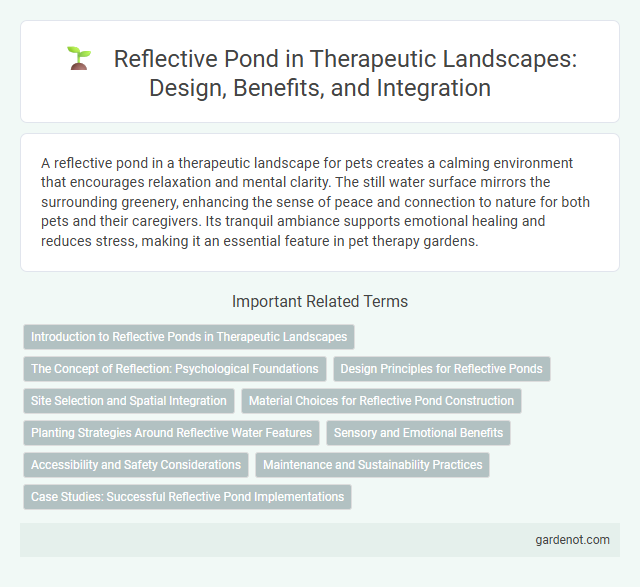A reflective pond in a therapeutic landscape for pets creates a calming environment that encourages relaxation and mental clarity. The still water surface mirrors the surrounding greenery, enhancing the sense of peace and connection to nature for both pets and their caregivers. Its tranquil ambiance supports emotional healing and reduces stress, making it an essential feature in pet therapy gardens.
Introduction to Reflective Ponds in Therapeutic Landscapes
Reflective ponds in therapeutic landscapes serve as tranquil water features that enhance mental relaxation and promote emotional healing through their calm surfaces and gentle sounds. These ponds are strategically designed to encourage mindfulness, reduce stress, and create a serene atmosphere that supports therapeutic practices such as meditation and nature therapy. Incorporating reflective ponds into healing gardens contributes to improved well-being by fostering a deep connection between individuals and natural surroundings.
The Concept of Reflection: Psychological Foundations
A reflective pond embodies the psychological concept of reflection by creating a tranquil environment that promotes mindfulness and self-awareness. The still water surface mirrors both the physical surroundings and the observer's inner state, facilitating introspection and emotional regulation. This interplay between the external and internal worlds enhances therapeutic outcomes by encouraging mental clarity and stress reduction.
Design Principles for Reflective Ponds
Reflective ponds in therapeutic landscapes utilize principles of symmetry, stillness, and visual clarity to create calming environments that enhance mindfulness and relaxation. Proper placement maximizes natural light reflection and surrounding greenery integration, promoting restorative experiences. Materials and edges are carefully selected to ensure safety while maintaining aesthetic harmony and water quality.
Site Selection and Spatial Integration
Choosing a reflective pond location within a therapeutic landscape requires careful site selection to maximize natural light exposure and minimize noise pollution, enhancing tranquility and visual appeal. Spatial integration involves positioning the pond to serve as a central focal point, promoting mindfulness and relaxation through sightlines that connect water reflections with surrounding vegetation and seating areas. Proper alignment with topography and accessibility ensures seamless interaction, fostering a cohesive environment for therapeutic benefits.
Material Choices for Reflective Pond Construction
Selecting durable materials like natural stone or reinforced concrete enhances the longevity and aesthetic appeal of reflective ponds in therapeutic landscapes. Using non-toxic liners and smooth, UV-resistant surfaces ensures water clarity and reduces maintenance, promoting a serene environment. Incorporating local or recyclable materials supports sustainability while blending the pond seamlessly into its natural surroundings.
Planting Strategies Around Reflective Water Features
Planting strategies around reflective ponds prioritize species with slender, upright foliage to enhance water's mirror-like quality and avoid obstructing reflections. Selecting native, moisture-loving plants such as Carex, Juncus, and Iris creates natural edges that stabilize soil and improve water quality. Incorporating evergreens and seasonal bloomers adds year-round visual interest while maintaining the tranquil, meditative atmosphere essential to therapeutic landscapes.
Sensory and Emotional Benefits
A reflective pond enhances therapeutic landscapes by promoting sensory engagement through gentle water sounds and visual tranquility, fostering deep emotional relaxation. The mirror-like surface invites mindfulness and introspection, helping reduce stress and anxiety levels. Immersive sensory experiences in such environments support mental restoration and emotional healing.
Accessibility and Safety Considerations
Reflective ponds in therapeutic landscapes must incorporate accessible pathways with smooth, non-slip surfaces and appropriate gradients to accommodate individuals with mobility challenges. Safety features such as clear sightlines, gentle water depths, and unobtrusive barriers reduce drowning risks while maintaining tranquility. Proper lighting and signage enhance navigation and awareness, ensuring an inclusive, secure environment for all users.
Maintenance and Sustainability Practices
Reflective ponds require regular maintenance practices such as debris removal, algae control, and water quality monitoring to preserve their therapeutic benefits. Sustainable methods include using native aquatic plants to naturally filter water and implementing rainwater harvesting systems to minimize resource consumption. Consistent upkeep ensures the pond remains a calm, restorative element within a therapeutic landscape.
Case Studies: Successful Reflective Pond Implementations
Case studies of successful reflective pond implementations highlight their role in enhancing therapeutic landscapes by promoting tranquility and mental restoration. Notable examples include the Memorial Healing Garden in Singapore and the Chihuly Garden and Glass in Seattle, where reflective ponds integrate with natural elements to create immersive, meditative environments. These projects demonstrate how strategic placement and design of reflective water features support stress reduction and improve overall well-being for visitors.
Reflective pond Infographic

 gardenot.com
gardenot.com